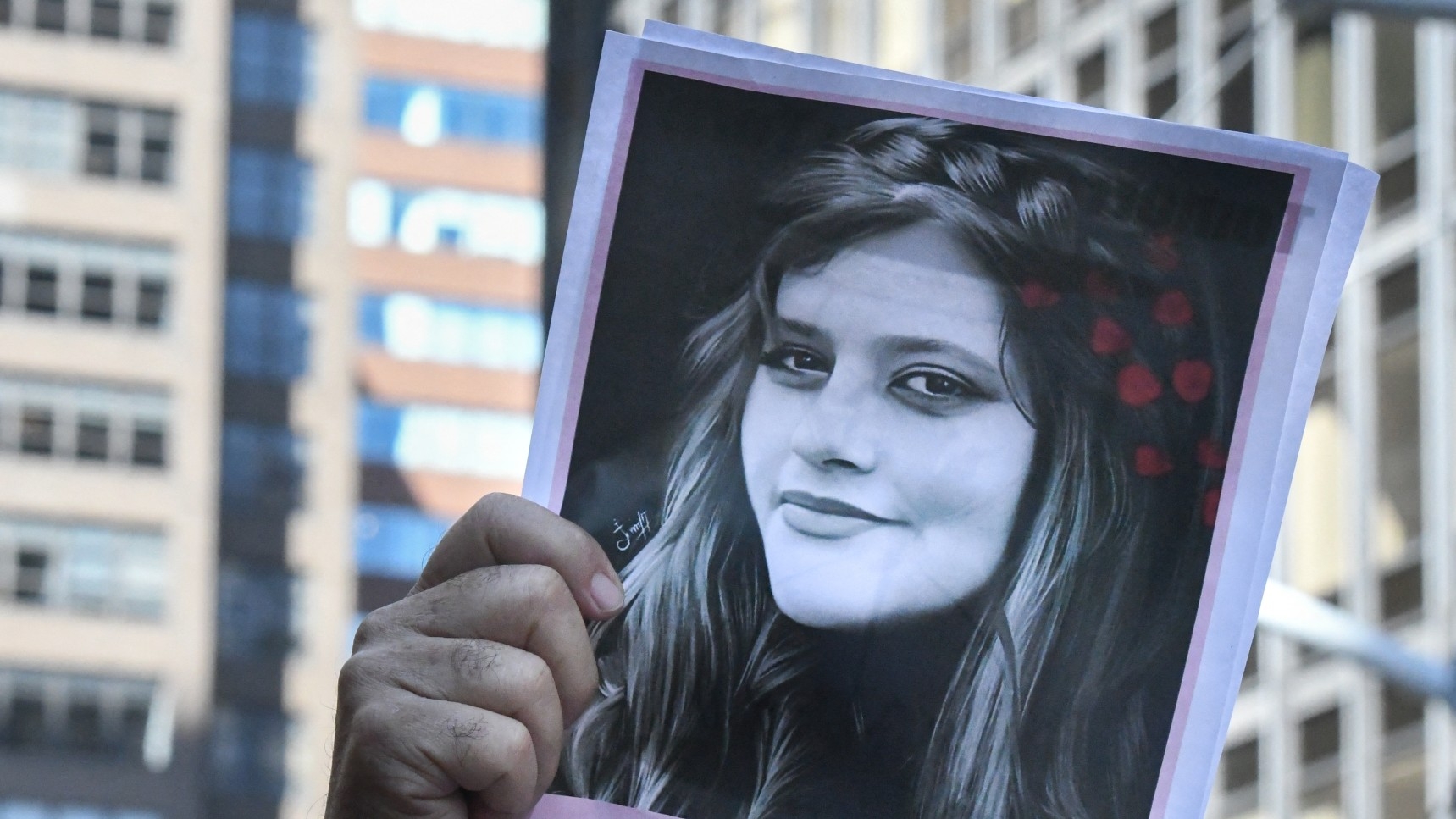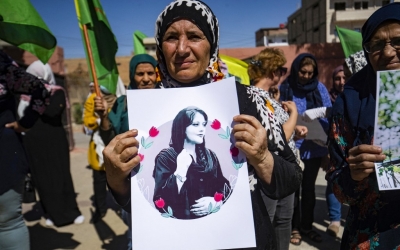How Iranian women's bodies became an ideological battleground

The death in custody of a young Iranian woman, Mahsa (Zhina) Amini, has once again brought the issue of mandatory veiling in Iran to global attention.
Amini was a 22-year-old woman from Saqqez in the northwestern Kurdish region of Iran visiting her family in Tehran. On 16 September she was arrested in the streets of Tehran by a unit of the so-called "morality police" or Gasht-e Ershad, as it is known and feared in Iran, presumably physically assaulted, and while in custody went into a coma and died.
Iranian officials including President Ebrahim Raisi have called for an investigation into her death. Raisi has also called Amini’s family expressing his condolences.
Extreme caution is necessary not to confuse this coterie of agent provocateurs outside Iran with the real uprising inside the country
But this was too little too late. Widespread protests are reported from across the country - and scores have been reported killed - with Amini's tragic death serving as a trigger point unleashing much pent-up anger and frustration against the ruling regime.
While the organs of the state try to downplay the incident, and violently crush the protests, expat journalists gathered in venues like BBC Persian or Radio Farda habitually up the ante in what they report and cast the entire protest as an indication that the regime in Tehran is about to fall.
The discredited Mujahideen-e Khalq (MEK) and the monarchists surrounding the former Shah’s son Reza Pahlavi have joined professional agitators in the deep pocket of US regime changers and jumped on the bandwagon of using this incident for their own political purposes.
A strong Islamophobic component of Iranian keyboard activism has also abused the occasion to demonise the whole idea of Muslim women’s dress habits. Extreme caution is therefore necessary not to confuse this coterie of agent provocateurs outside Iran with the real uprising inside the country. There are plenty of Ahmad Chalabi and Kanan Makiya wannabes amongst Iranian expats too.
'Morality' and class
The terror that the ideologues, the Salafi and Taliban-like component of the regime in Iran, perpetrates on its citizens is not limited to, but starts with, regulating the dress codes of Iranian woman - particularly poor and middle-class Iranian women.
Women in the richer and more opulent parts of Tehran care very little for such codes, and the so-called "morality police" that is itself formed mostly of poor and middle-class families dares not to go anywhere near them.
The power dynamic here between the rich and the poor - the powerful and the powerless - reveals a systemic banality that defines the very fabric of Iranian society under the rule of the Islamic regime.
Decades of US sanctions against Iran have exacerbated the frightful chasm between the very poor and the obscenely rich in Iran. The supporters and enablers of the ruling regime have amassed astronomical wealth through shady business practices and deep-rooted corruption.
In an essay published in 2009, Djavad Salehi Isfahani, a widely respected US-based Iranian economist, summed up the post-revolutionary condition succinctly: "Inside Iran the facts regarding the evolution of equality are hotly debated. However, data from the Statistical Center of Iran offer evidence of how inequality has changed in terms of household expenditures, education attainment, and access to health and basic services. The picture that emerges is a mixed one: success in improving the standard of living and the quality of life for the poor, and failure in improving the overall distribution of income."
Since that article was published, things had drastically changed for the worse - due in part to the crippling US sanctions. While the social uprising during 2017-2018 - just a decade after the article's publication - was mostly fuelled by the poor and for economic reasons, the current uprising has linked those enduring economic problems with the more middle-class social concerns over the abusive behaviour of the state towards women and mandatory veiling.
As the 2017-2018 uprising revealed, the economic fault lines of the ruling regime, and the protests triggered by the killing of Amini in custody reveal the frustrated aspirations of a highly able and wired generation with a different conception of themselves than the totalitarian state allows them to express.
From mandatory veiling to mandatory unveiling
Despite the coalescence of other equally, if not more important economic issues, at the heart of these current protests is the mandatory veiling of Iranian women against their will.
To be sure, there are millions of Iranian women who wear the hijab voluntarily and proudly as a sign of their faith and identity. But there are also millions of other women who do not wish for the practice to be violently imposed on them.
The mandatory veiling that was initiated soon after the Islamic Republic took over was in direct challenge to the mandatory unveiling, or kashf-e hijab, that Reza Shah Pahlavi had imposed on Iranian women when he took power in the 1930s.
Two tyrants, Reza Shah and Ayatollah Khomeini focused on policing women’s bodies as the site of their respective ideologies of power and domination, with the bodies of women as the ideological battleground of their patriarchal practices.
The first massive social protest against the Islamic Republic mandatory veiling took place on International Women’s Day, 8 March 1979. More than 40 years later, the regime has miserably failed to impose its vicious policing of women’s bodies on its defiant citizens.
Two tyrants, Reza Shah and Ayatollah Khomeini, focused on policing women’s bodies as the site of their respective ideologies of power
What we are witnessing in Iran in the imposition of mandatory veiling is, of course, the reverse of what we see in much of Europe and North America where Muslim women are systematically harassed if they choose to wear the Muslim hijab. For decades not a single day passes without a racist, misogynist, bigoted violent attack on Muslim women in Europe and the US.
According to the Southern Poverty Law Center, the highly respected institution documenting hate crimes, “Anti-Muslim hate groups are a relatively new phenomenon in the United States, with many appearing after the 11 September 2001 terrorist attacks. These groups broadly defame Islam and traffic in conspiracy theories of Muslims being a subversive threat to the nation. This gives rise to a climate of fear, hate and intimidation directed towards Muslims or those perceived to be."
Muslim women who wear the hijab are the primary target of this whole industry of Islamophobia for they are the most visible. These crimes are not just the work of a gang of racist goons well-funded by Islamophobic millionaires.
Throughout Europe as well as in the US there has been legislation targeting Muslim women and their hijab. Full or partial bans of the Muslim hijab have been introduced in Austria, France, Belgium, Denmark, Bulgaria, the Netherlands, Germany, Italy, Spain (in some localities of Catalonia), Switzerland, Norway and elsewhere.
The US is not any better. In a major article for Hastings Race and Poverty Law Journal in 2008, Aliah Abdo writes: “The First Amendment of the United States Constitution guarantees freedom of religion, however the current sociopolitical and legal climate has allowed for various restrictions on hijab, the headscarf worn by Muslim women.”
The article, titled "The Legal Status of Hijab in the United States", details "restrictions and bans affecting the wearing of hijab in educational settings, employment, prison entry, state driver's licence photos, athletic competitions, airports, and in court, noting an alarming trend both internationally and domestically.”
Forced unveiling in North America, Europe, or India, is as pernicious as forced veiling in Iran, Afghanistan, or any other part of the Muslim world. Both practices, though opposite to each other in appearance, are identical in reality, turning the body of a Muslim woman into a battleground of opposing ideologies of bodily control and biopower. Insisting on the choice to wear the hijab is therefore as vital in North America and Europe as the right not to wear it in places like Iran or Afghanistan.
The world at large can no longer allow for hypocrisy and double standards of the subjugation of women as second-rate citizens in their own homelands. No European country or the US can denounce the abusive behaviour of the Iranian state while harbouring the most vicious forms of Islamophobia targeting Muslim women in their own countries.
A woman-led uprising
The violent behaviour of the ruling Islamist regime in Iran is both concerning and embarrassing to those Muslim women in and outside of Iran who choose to wear hijab, and do so as a matter of pride and identity. It is impossible to imagine a Muslim woman who chooses to wear the hijab in the US or Europe or anywhere else condoning its violent imposition on women who do not wish to wear it.
Beware of the gimmicks and counterfeits of US-based regime changers featuring a career opportunist as the spokesperson for their own pathetic interests
The death of Amini in Iran has already marked a massive social uprising across the county, once again revealing to the whole world the fact that the ruling regime has violently imposed a draconian jurisprudence of fear and intimidation to sustain its tyrannical hold on power.
The propaganda, security, intelligence, and military apparatus of the regime may or may not succeed in crushing this uprising as it has in previous gestations.
But the indubitable fact remains that the Islamic Republic as a state apparatus has categorically failed to generate an iota of legitimacy for itself more than 40 years after it stole the dreams and aspirations of a democratic future for millions of Iranians.
Towards that democratic future, the most significant positive outcome that can happen from this uprising is if women were to lead it and define its course and consequences. But "women" should not be taken as a generic term, as two intersections are crucial: the dynamics of class and the symbolism of veiling.
The legitimate cause of women’s choice in wearing or not wearing the hijab must intersect with the dynamics between the working and the middle class. When veiled and unveiled women, working and middle-class women, come together to lead this uprising then at last we will have a revolution to behold.
Before then beware of the gimmicks and counterfeits of US-based regime changers featuring a career opportunist as the spokesperson for anything other than their own pathetic interests.
No one speaks for Amini except the loud but muted voices of a massive social uprising in search of the terms of its own emancipation. Put your ears to the ground and listen carefully. The subaltern around the world does not speak English.
The views expressed in this article belong to the author and do not necessarily reflect the editorial policy of Middle East Eye.
Middle East Eye propose une couverture et une analyse indépendantes et incomparables du Moyen-Orient, de l’Afrique du Nord et d’autres régions du monde. Pour en savoir plus sur la reprise de ce contenu et les frais qui s’appliquent, veuillez remplir ce formulaire [en anglais]. Pour en savoir plus sur MEE, cliquez ici [en anglais].






